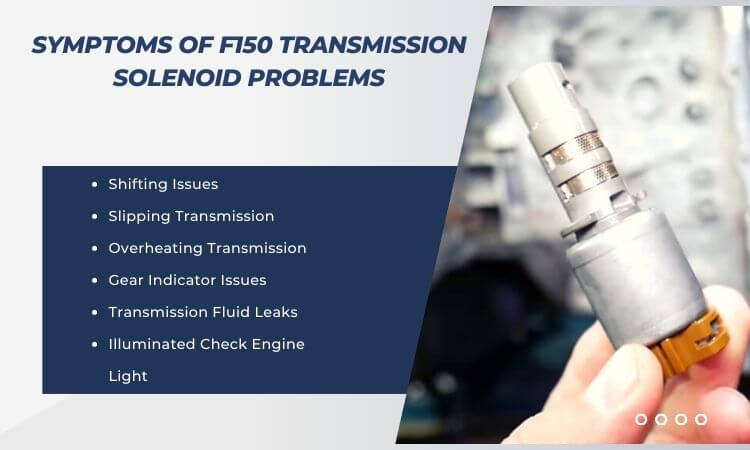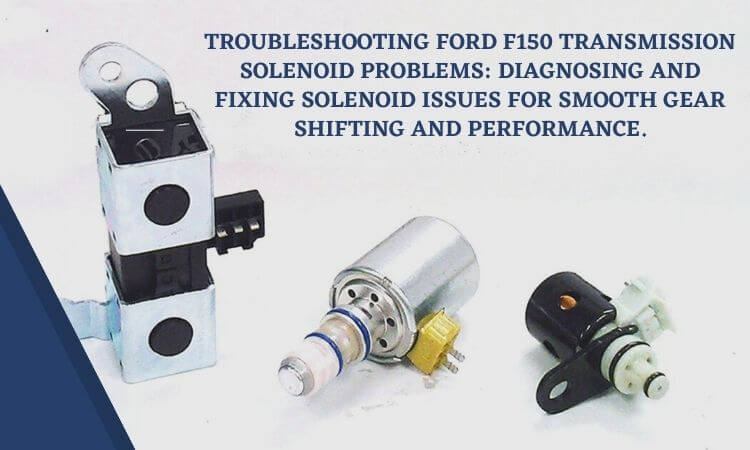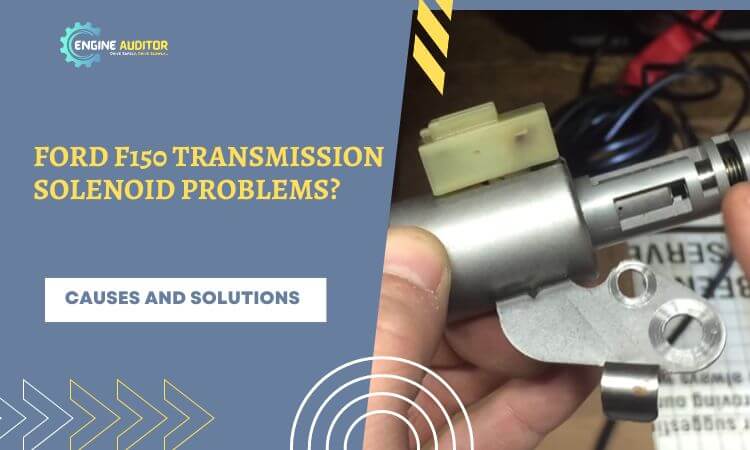Hey there! This post contains affiliate links to products. We may receive a commission for purchases made through these links. But it never influences our product selection process.
The transmission solenoid in a Ford F150 is essential for ensuring smooth gear shifting and overall transmission performance. However, like any mechanical component, it can encounter problems over time. It is essential to immediately check for problems and fix them to access a smooth gear-shifting experience. It may not seem easy to you but can fix the issue once you find its cause.
- First, check for transmission slipping and ensure it is okay.
- Next, look for any stuck gear; if you find any, fix it.
- Also, check for transmission system overheating and eliminate the problem.
- Inspect tiny sensors to make sure they are working properly.
- Lastly, check for leakage and ensure there are no transmission fluid leaks.
This article aims to provide a comprehensive guide on troubleshooting Ford F150 transmission solenoid problems, offering valuable insights and solutions to help owners diagnose and address these issues effectively. Stay tuned here and learn how I fix that issue in detail step-by-step. Let’s get started.
Symptoms of f150 Transmission Solenoid Problems

Here are the few major symptoms that you may experience when have f150 transmission solenoid problems:
- Shifting Issues: Difficulty shifting gears or experiencing erratic shifting patterns.
- Slipping Transmission: Transmission slipping between gears or slipping out of gear.
- Overheating Transmission: The solenoid’s malfunction is the cause of the transmission’s overheating.
- Gear Indicator Issues: Incorrect or inconsistent display of the gear on the instrument cluster.
- Transmission Fluid Leaks: Leaking transmission fluid, often resulting from a faulty solenoid seal.
- Illuminated Check Engine Light: The check engine light turning on, indicating a transmission-related problem.
If you are facing an issue with Fordpass remote start, this guide provides solutions to troubleshoot and resolve the problem.
Causes of Ford f150 Transmission Solenoid Problems
The causes for Ford f150 transmission Solenoid problems vary from situation to situation. However, I have mentioned the top 5 causes that need checking for quick fixation of the issue.
- Transmission Slipping
- Stuck in a Single Gear
- Overheating of Transmission
- Faulty Sensor
- Transmission Fluid Leaks
Ford f150 Transmission Solenoid Problems and Solutions]

Problem 1: Transmission Slipping
Transmission slipping is a common problem in a Ford F150 for solenoid problems. It can occur due to worn-out clutches, bands, or low fluid levels. It may lead to improper gear engagement and loss of power transmission.
Solution:
- Check for symptoms like improper gear engagement or loss of power transmission.
- Then check the transmission fluid level and its condition. If required, refill the fluid. I recommend Pentosin Full Synthetic Automatic Transmission Fluid.
- Also, try to check for worn-out clutches or bands that may cause slipping.
- Fix the issue by replacing worn-out parts.
- Test the transmission to ensure proper gear engagement and power transmission to eliminate the problem.
Note: When changing your 2015 f150 transmission fluid, follow these detailed steps to ensure a successful fluid replacement, promoting smooth shifting and prolonging the lifespan of your transmission.
Problem 2: Stuck in a Single Gear
Being stuck in a single gear with a Ford F150 can result in solenoid problems. A malfunction in the transmission’s shift solenoids can cause the transmission to remain in one gear and affect overall performance.
Solution:
- First, observe the symptoms such as transmission remaining in one gear, lacking response, or experiencing rough shifting.
- Use an OBD-II scanner to retrieve any transmission-related error codes. I recommend the iCarsoft Obd2 Scanner for that purpose.
- Now, inspect the shift solenoids and check the solenoids for clogs or electrical issues. Repair the required parts.
- Then use the scanner to clear any stored error codes.
- Take a test drive to ensure proper shifting and performance.
Problem 3: Overheating of Transmission
You may experience transmission solenoid issues due to overheating the transmission in a Ford F150. It can happen due to increased friction and wear, fluid degradation, and possible damage to the solenoid valves.
Solution:
- Check for signs of overheating, such as a burning smell or excessive fluid temperature.
- Check the transmission fluid level and condition if there is overheating to make sure it is at the proper level and not burned.
- Next, verify the cooling system’s functionality, including the radiator, cooling fan, and transmission cooler.
- Repair or replace damaged components, such as a faulty cooling fan or a clogged radiator.
- You can also consider upgrading the transmission cooler for better heat dissipation.
Problem 4: Faulty Sensor
A faulty sensor in a Ford F150 can cause transmission solenoid problems. A faulty sensor provides incorrect data to the vehicle’s computer, which leads to improper functioning of the solenoids.
Solution:
- First, identify the faulty sensor by connecting an OBD-II scanner and reading the trouble codes related to the transmission solenoid.
- Once identified, locate the sensor based on the trouble code. You can also take help from the vehicle’s service manual.
- Once found, check for sensors for physical damage or loose connections. Replace or tighten if necessary.
- Clear the trouble codes using the OBD-II scanner to reset the system.
- Take a vehicle test drive to ensure the transmission solenoid problem is resolved.
Problem 5: Transmission Fluid Leaks
Transmission fluid leaks in a Ford F150 can lead to solenoid problems. It can reduce fluid pressure, causing inadequate lubrication and potentially damaging the solenoid valves or other components. Ultimately, you may experience improper shifting and transmission issues.
Solution:
- Start by looking for leak signs, such as puddles of reddish fluid under the vehicle.
- If you see the signs, check the transmission pan, gasket, and seals for damage or wear.
- Also, check the cooler lines, transmission cooler, and radiator for leaks.
- Replace damaged components and tighten loose connections as required.
- Refill the transmission fluid if required to reach the correct level using the recommended fluid type.
- Remember to take a test drive to ensure proper shifting and transmission operation.
In addition to the F150, knowing the process for changing transmission fluid in other vehicles is beneficial. Learn the steps for a 2014 Silverado transmission fluid change and a 2017 Honda Civic transmission fluid change to maintain optimal performance in these specific models.
How to Test Ford Transmission Solenoid?
Testing the Ford transmission solenoid is not a complex task, if you follow the steps below. By following these steps you can test it in a couple of minutes.
- First, park your vehicle on a flat surface.
- Remember to engage the parking brake.
- Then, locate the transmission solenoid. It is usually mounted on the transmission housing.
- Disconnect the electrical connector from the solenoid.
- Take a multimeter and test the resistance of the solenoid.
- If the resistance is outside the recommended range, replace the solenoid. If it falls within the range, proceed to the next step.
- Apply voltage to the solenoid using a 12-volt power source. Connect the positive lead to one terminal and the negative lead to the other.
- Carefully, listen for a clicking sound, indicating that the solenoid is activating properly.
- But if you do not hear the clicking sound, the solenoid may be faulty. It needs replacing.
- Reconnect the electrical connector to the solenoid.
- Clear any error codes using an OBD-II scanner.
- Take a test drive and ensure the solenoid is functioning correctly.
Ford f150 Transmission Solenoid Replacement
The Ford F150 transmission solenoid replacement involves replacing the electrical component responsible for controlling the transmission fluid flow. To replace it follow the steps below.
- Start with Locating the transmission solenoid on your Ford F150. It is usually mounted in the transmission valve body in the Ford f150.
- Disconnect the battery to ensure safety.
- Then remove the electrical connector from the solenoid switch.
- Take a wrench or socket and loosen the bolts.
- Then remove the bolts securing the solenoid to the transmission.
- Remove the old solenoid and replace it with the new one.
- Tighten the bolts to secure the new solenoid.
- Reconnect the electrical connector.
- Reconnect the battery.
- Test the transmission to ensure proper functioning.
Transmission Solenoid Repair Cost:
The estimated cost for transmission solenoid repair can vary for different makes and models of the vehicle. On average, it can be in a range from 200 to 500 dollars for replacing parts and labor.
Frequently Asked Questions (FAQs):
What does a transmission solenoid do?
How do you reset a transmission solenoid?
02. Disconnect the battery to reset the system.
03. Reconnect the battery after a few minutes.
04. Start the car and test the transmission for proper functioning.
How can you bypass an F150 transmission solenoid?
Tips to prevent ford f150 solenoid problems
02. Keep the solenoids clean and free from debris.
03. Use high-quality transmission fluid and follow the recommended service intervals.
04. Avoid excessive towing or hauling to reduce strain on the solenoids.
05. Address any warning signs promptly and seek professional assistance when needed.
Conclusion
The transmission solenoid ensures the smooth functioning of the transmission system. Ford f150 transmission system is consistent and reliable. However, you may face some issues from time to time. Whenever you face transmission system issues, you must check for transmission solenoid issues.
By timely fixing the transmission solenoid issue, you can prevent your vehicle and ensure safety on the road. You can fix it by following my instructions given above. However, if you are confused about your skills, contact a professional mechanic to fix the problem properly.

